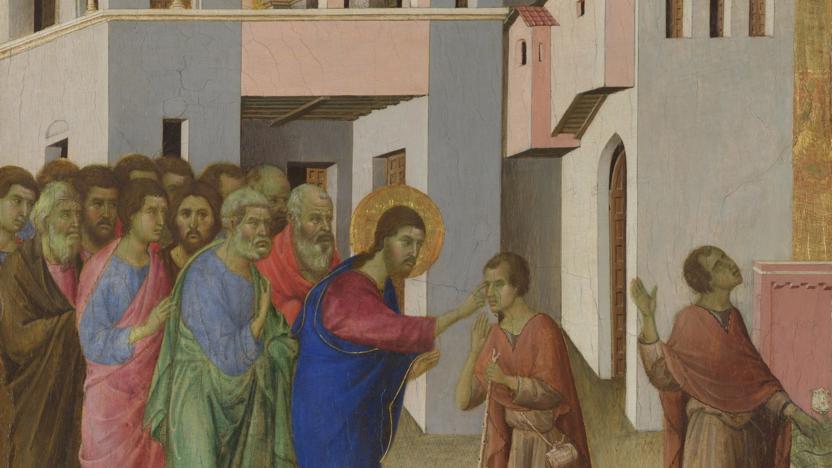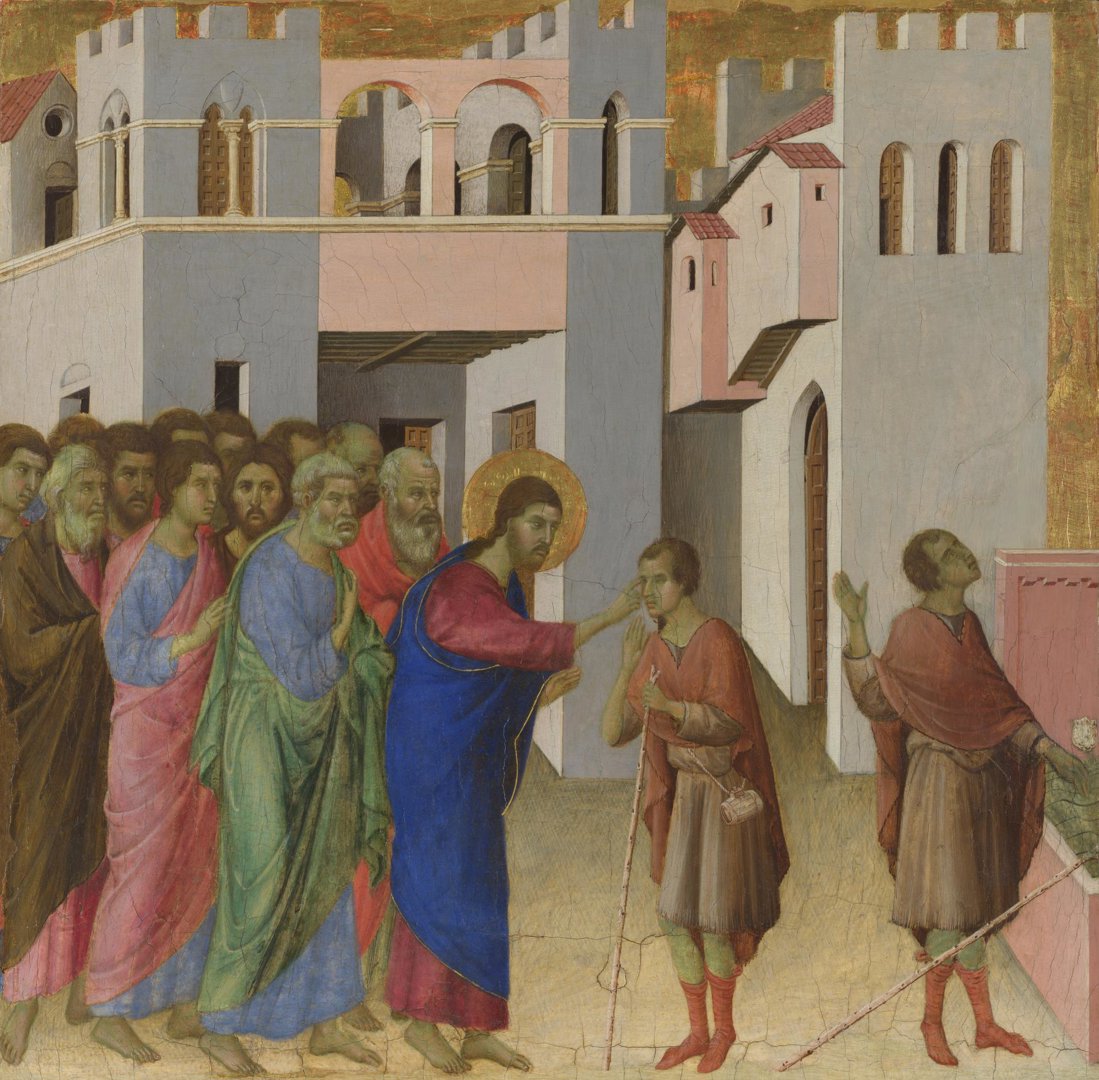Duccio's 'The Healing of the Man born Blind'
Audio description
Listen to an audio description of Duccio's 'The Healing of the Man born Blind'
This is a detailed visual description of the painting The Healing of the Man Born Blind by the Sienese artist Duccio di Buoninsegna who was painting around the turn of the 14th century. It will take about 8 minutes to listen to and includes information about the story depicted and how Duccio made the work.
The small, square painting, measures 45 by 47 cm. It is painted onto a wooden panel. The panel was part of the predella (the bottom tier) of Duccio’s 'Maestà' – a huge double-sided altarpiece made for the high altar of Siena Cathedral. Finished in 1311 it was one of the largest and most complex altarpieces ever produced.
This panel depicts a Bible story from the Gospel of Saint John. In the story Jesus heals a blind beggar by wiping a mixture of mud and his own spittle across the man’s eyelids. After following instruction to wash in the pool of Siloam the man was then able to see.
In the painting the miracle takes place on a stretch of sandy ground in front of a complex architectural structure which represents a walled city. A row of 15 men stretches across the bottom half of the painting, with Christ performing the miracle on the blind man at the centre of the group. A huddle of disciples crowd behind Christ, filling the bottom left-hand quarter of the painting. Strikingly - to the right of Christ, Duccio has painted the figure of the Blind Man twice, showing him during, and after Christ’s miracle has been administered.
The city takes up the top two-thirds of the painting. If we could step into the picture, it would take 9 or 10 paces to reach its walls. It is reminiscent of a child’s fairy-tale castle. Three light-grey towers with crenelated tops are linked by pastel-pink ramparts and walkways. There are many arched windows and doorways with hints of tiled roofs and window shutters visible between them. Though only two stories tall, we sense that these buildings would tower over us at quite some height.
The three towers, left, right and centre, are constructed of angular cuboid forms depicted in perspective. If we could feel the picture surface, we could make out incised lines, scored with a sharp implement along a ruler, marking out their crisp edges. Though painted with a sense of perspective, the buildings spatial construction does not quite make sense. Medieval painters of the time were helped by many assistants and apprentices in their workshops, and it is likely that another artist helped with this part of the painting.
Instead of Roman-occupied Jerusalem, where the event was believed to have happened centuries earlier, Duccio has set the miracle in a city of turreted towers similar to a European medieval city like Siena, bringing it to life for the people.
Christ and the Man born Blind are at the front centre of the composition, turned in towards each other, in three quarter view to us. Christ is a foot taller than the Blind Man. He stoops over and reaches out the index finger of his right hand to anoint the blind man’s eyes with the salve of mud and spittle.
The miracle is performed in front of a crowd of 12 disciples, packed closely together behind Christ. Their height reaches to the midway point of the painting. Their heads block our view into the windows and doors on the ground floor of the buildings behind them. The toes of their bare feet meet the bottom edge of the picture, as though they are tiptoeing along it. They form a solid block of figures, covering the bottom-left quarter of the painting, stretching back to its left edge.
Three full-length figures form a row behind Christ. They are colourfully dressed in long cloaks of brown, pink, and mint-green over pale-blue robes. The rest of the disciples peer over their shoulders, only their heads or their hairlines are visible.
Christ stands out as he is dressed in a vivid ultramarine blue cloak, edged with a fine gold line. This most expensive of colours, reserved only for special figures, was made by grinding up the semi-precious lapis-lazuli stone and mixing the powder with egg yolk. He has a brown moustache and a short beard. A slight rosy glow to his cheek is mixed with an olive-green tinge to his skin. This is caused by remnants of a green-earth pigment used as an underpaint, now showing through.
Christ wears his cloak over a scarlet-coloured robe. He is the only figure in the painting who has a halo. The halo is made of real gold-leaf and sits exactly at the centre-point of the painting.
A warm light radiates from the sky and background which, rather than depicting a landscape, is also covered in gold leaf. At the time that Duccio was painting, Italy was made up of several independent city states, with their own individual artistic styles. While Florentine artists turned their attentions to more realistic depictions of the natural world, Siena preferred to adapt existing Byzantine traditions of painting, retaining much of the decorative and mystical power of this earlier style. Duccio’s figures are quite flat, stacked behind one another like paper playing cards. This emphasises the patterns and rhythms of the curved lines of the hems of their cloaks and their arms, which they raise to steady themselves against the men in front as they strive to witness the miracle.
The Man born Blind is depicted twice. Duccio uses this Byzantine convention of showing the same figure multiple times in one painting as a solution to telling a story which unfolds over time. We know it is the same man because they are dressed identically – both wear a pink robe with darker pink boots and have short brown receding hair.
The first figure of the Blind Man who faces Christ, raises up his right hand towards his eye as Christ anoints it. In his left hand he holds a wooden staff, used to guide him. The second figure of the Blind Man stands to his right, beside a pink street fountain, shaped like a bed built of stone. This pool is cut off by the right-hand edge of the painting. On the ‘headboard’ end on the fountain is a sculpted lion’s head. Green water gushes from its mouth. The Blind Man faces away from the crowd - looking upwards and outwards, beyond the right-hand edge of the painting. His staff has fallen from his hand and rests on the side of the pool. He no longer needs it to guide him as he can now miraculously see.
The story appears negative towards the identity of the Man born Blind. Shown as a shorter and frailer figure than the others, he has not sought to have his eyesight restored. When the disciples surround Jesus and the Blind Man, they assume that someone is to blame for the man’s blindness, asking Jesus whether it is the man himself or his parents who sinned.
But in offering the miracle Jesus makes use of the moment to deliver a metaphorical teaching – that he came into the world ‘so that the blind (meaning the spiritually blind) may see’. Christ rejects the disciples’ prejudiced notion that blindness is the result of wrongdoing. It is they who are metaphorically blind as they cannot see the unjust damage they do in assuming it is the result of having sinned.
What the once Blind man now ‘sees’ goes far beyond the visual and the physical world. The scene that Duccio placed directly to the right of this painting was a picture of 'The Transfiguration', showing the moment when Jesus was filled with divine light. (This is also in the Gallery’s collection). The ‘healed’ man would have gazed up towards the transfigured Christ, acknowledging the source of his healing but also recalling Jesus’ words to his disciples as he performed the miracle: ‘While I am in the world, I am the light of the world’.


